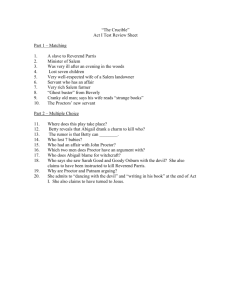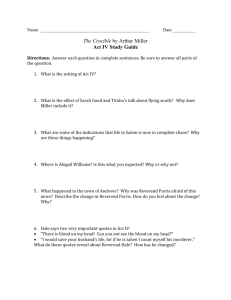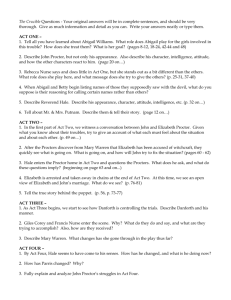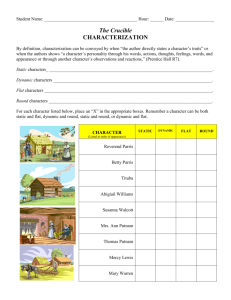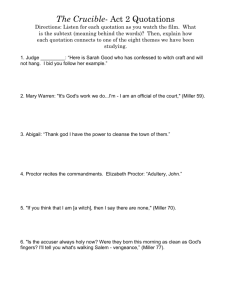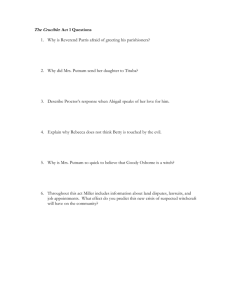The Crucible Test Study Guide Notes 2013
advertisement
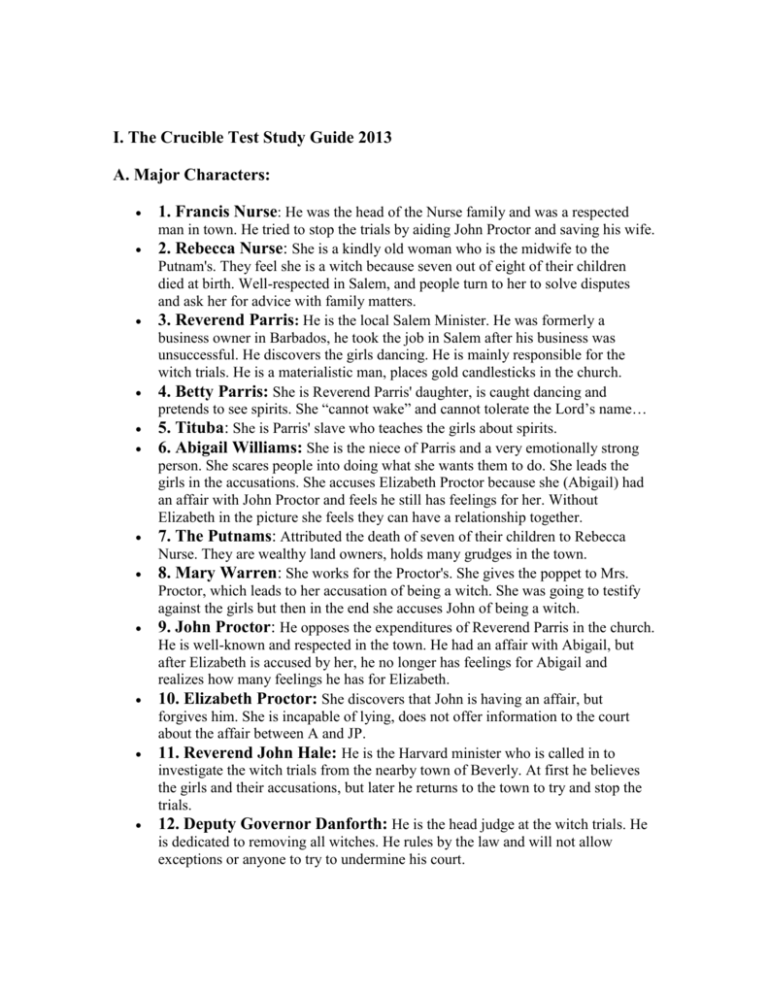
I. The Crucible Test Study Guide 2013 A. Major Characters: 1. Francis Nurse: He was the head of the Nurse family and was a respected man in town. He tried to stop the trials by aiding John Proctor and saving his wife. 2. Rebecca Nurse: She is a kindly old woman who is the midwife to the Putnam's. They feel she is a witch because seven out of eight of their children died at birth. Well-respected in Salem, and people turn to her to solve disputes and ask her for advice with family matters. 3. Reverend Parris: He is the local Salem Minister. He was formerly a business owner in Barbados, he took the job in Salem after his business was unsuccessful. He discovers the girls dancing. He is mainly responsible for the witch trials. He is a materialistic man, places gold candlesticks in the church. 4. Betty Parris: She is Reverend Parris' daughter, is caught dancing and pretends to see spirits. She “cannot wake” and cannot tolerate the Lord’s name… 5. Tituba: She is Parris' slave who teaches the girls about spirits. 6. Abigail Williams: She is the niece of Parris and a very emotionally strong person. She scares people into doing what she wants them to do. She leads the girls in the accusations. She accuses Elizabeth Proctor because she (Abigail) had an affair with John Proctor and feels he still has feelings for her. Without Elizabeth in the picture she feels they can have a relationship together. 7. The Putnams: Attributed the death of seven of their children to Rebecca Nurse. They are wealthy land owners, holds many grudges in the town. 8. Mary Warren: She works for the Proctor's. She gives the poppet to Mrs. Proctor, which leads to her accusation of being a witch. She was going to testify against the girls but then in the end she accuses John of being a witch. 9. John Proctor: He opposes the expenditures of Reverend Parris in the church. He is well-known and respected in the town. He had an affair with Abigail, but after Elizabeth is accused by her, he no longer has feelings for Abigail and realizes how many feelings he has for Elizabeth. 10. Elizabeth Proctor: She discovers that John is having an affair, but forgives him. She is incapable of lying, does not offer information to the court about the affair between A and JP. 11. Reverend John Hale: He is the Harvard minister who is called in to investigate the witch trials from the nearby town of Beverly. At first he believes the girls and their accusations, but later he returns to the town to try and stop the trials. 12. Deputy Governor Danforth: He is the head judge at the witch trials. He is dedicated to removing all witches. He rules by the law and will not allow exceptions or anyone to try to undermine his court. 13. Giles Corey- older farmer who refuses to admit to witchcraft, suffers a painful death by crushing weight. Quote “More Weight.” 14. Cheever- becomes the sergeant-at-arms and officer of the court, acts as a police officer and investigator. B. Plot summary: 1. Abigail and the girls are dancing in the woods. They conjure up spirits while dancing naked and they are discovered by Reverend Parris. This leads to the accusations of the girls as witches. Then to escape punishment they accuse other women of the town of being witches. (Tituba, Sara Good, Sara Osborne) This leads to trials of these women with the girls as the accusers. 2. John Proctor had an affair with Abigail. Elizabeth Proctor knows of the affair. Abigail then accuses Elizabeth Proctor of being a witch. A doll/with a pin is found in the Proctor's house and this is overwhelming evidence that she is a witch. (According to the court) 3. Deputy Governor Danforth is the judge. He believes the girls are telling the truth. Meanwhile they are accusing the women whom they do not like. (And people their parents dislike and are suspicious of or whom they have had conflicts with before) Reverend Hale is called in as an expert witness. He at first believes they are witches, but then he denies it and tries to help the accused. 4. Proctor gets Mary Warren to testify against the girls. When Mary Warren enters the court room, Abigail and the other girls start to scream that she is sending her spirit upon them. Mary, then afraid, accuses John Proctor of sending his spirit out upon her. 5. John is now accused of being in league with the devil. He discusses the possibility of lying in order to save his life. Danforth wants him to sign a confession. This way it will show the townspeople that the witch trials are valid. John does not want to sign the confession because he doesn't want to incriminate his friends. He is then put to death, but retains his good name and pride. C. Major Themes: 1. Pride - John does not want to sign the confession because he would loose his pride and good name. 2. Revenge - The girls and the accusers were naming people whom they did not like and wanted to harm them. 3. Conflict of authority - Danforth felt the law should be followed exactly, and that anyone who opposed the trials was trying to undermine him and his authority and the church. 4. Honesty- Elizabeth was "not able to tell a lie". 5. Fear, self interest: Shows what happens when emotions control your logic and thinking. Hysteria will occur. Shows how people will accuse others in order to save themselves. This leads to a wild finger pointing. Also when you were accused of being a witch, in order to save yourself you could accuse other women. People in the town allowed their fear of witches and the devil to interfere with their rational thinking. 6. Puritan Ethics: The church was very important in their daily life. The Puritans were very religious. They were scared of modern things destroying the old church. They believed in the devil and that you could make pacts with him. It was a horrible sin to lie. 7. Integrity: John had to deal with the fact that he had an affair with Abigail and broke the trust between Elizabeth and him. He sinned, and the people of the town would have condemned him, if they knew. The Crucible Test Breakdown Character ID’s (15) True and False (5) Multiple Choice (15) Identify the Speaker (10) Explain the significance of the quote (5) Short Answers (5-7) Essays (2)
